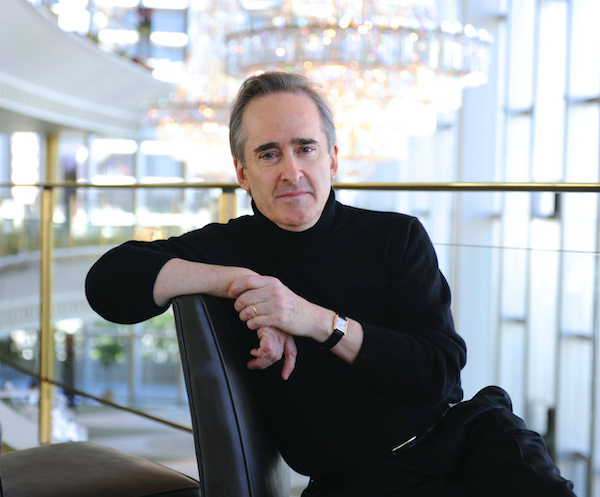Conlon’s sumptuous performance of neglected rarities steers Baltimore Symphony in a fresh new direction

James Conlon conducted the Baltimore Symphony Orchestra Friday night at Meyerhoff Symphony Hall. Photo: Bonnie Perkinson
The James Conlon era has begun at the Baltimore Symphony Orchestra.
The esteemed conductor began a three-year tenure as the ensemble’s artistic advisor last month. He joins music director laureate Marin Alsop at the helm, while the BSO conducts a multi-year international search for a new music director. Conlon led his first of three programs this season Friday night before a small but enthusiastic audience at Meyerhoff Symphony Hall.
Conlon has a long history with the area’s other major band, the National Symphony Orchestra. Yet, somewhat surprisingly, this performance was his debut at the podium in Charm City.
The evening was a sign of impressive things to come, beginning with the programming, two major symphonic works, one of which was heard for the first time in BSO history. In a passionate introduction, Conlon placed both pieces, William Dawson’s Negro Folk Symphony and Alexander Zemlinsky’s Die Seejungfrau, in the context of the Recovered Voices mission he has led for the past few decades.
Most works championed by Conlon under this rubric, including the Zemlinsky, were suppressed by the Nazi regime in Germany. Conlon extended the concept to include the Jim Crow era in the United States and the racial discrimination that led to Dawson’s symphony sinking into obscurity, even after a noteworthy premiere by Leopold Stokowski and the Philadelphia Orchestra at Carnegie Hall in 1934. “There is also a history of neglect in America,” he noted.
Associate principal horn player Gabrielle Finck gave solid, nostalgic form to the horn solo that opens the first movement, titled “The Bond of Africa.” The composer described this crucial motif as the link “taken out of a human chain when the first African was taken from the shores of his native land and sent to slavery.” Its energy percolated through the Allegro section, brought back in heraldic brass statements.
Conlon led the piece with confidence that spread to all parts of the orchestra. Incisive gestures helped coordinate crisp unity in the exuberant syncopation that buoyed the climaxes of the movement.
Dawson drew on a number of traditional spirituals in the piece, avoiding tunes that were too familiar. He further transformed these allusions by paraphrasing more than quoting directly, as with “Oh, My Little Soul Gwine-a Shine,” repurposed as the secondary theme of the first movement.
The second movement, “Hope in the Night,” plodded with strained weariness. Oscillating exhalations in the strings punctuated the plaintive wail of Jane Marvine on the English horn solo, taking up the “link” motif again. After the playful middle section, the tension of the movement returned, concluding with the relentless pulsing of a tom-tom.
In the ebullient third movement, the sound of the BSO continued to shine with confidence, another sign that the partnership with Conlon will be an exciting one. Dawson adapted two more spirituals for the finale’s themes, the second of which shares similarities with the link theme, accenting the musical heritage of two continents in African-American music. The return of the oscillating music from the second movement was especially radiant.
It was a joy to hear Conlon conduct Zemlinsky’s Die Seejungfrau again, some years after he led the piece with the NSO in 2014. Those concerts at the Kennedy Center were the first live performances of the new critical edition by Antony Beaumont, which Conlon also used in Baltimore. Based on the holograph score in the Library of Congress, this edition restores about five minutes of music the composer excised from the second movement after the premiere.
The BSO reveled in Zemlinsky’s even more extravagant orchestration — two piccolos, four clarinets, six horns, two harps — with Conlon providing careful calibration of sectional balances. Sonorous low brass powered the waves of the opening section, with the harp lumbering upward slowly, music that returned at the end of the third movement. Concertmaster Jonathan Carney crooned sweetly on the many violin solos representing the eponymous mermaid.
Conducting from memory, Conlon marshaled his forces cleanly, guiding both lush string serenades and the buffeting of storms in larger sections. The rubato of the second movement, brimming with sentimental waltzes, flowed and ebbed with tidal grace. The restored episode, music designated “In the realm of the Mer-Witch,” bubbled with eerie mystery.
The third movement began in moody urgency, leading to a conclusion that at first seems tragic. After the oceanic deep brass seem to overtake the lost mermaid, dissolving into sea foam, a rumble of the bass drum introduced the apotheosis of the mermaid, fragile sounds of glowing violins and cellos, an aureole of sound that lifted the mermaid to the heavens. Conlon held the audience in mostly rapt silence for a few blissful moments, something else to be cherished.
The program will be repeated 8 p.m. Saturday at Meyerhoff Symphony Hall. bsomusic.org; 410-783-8000
